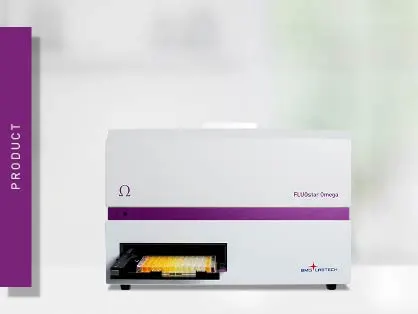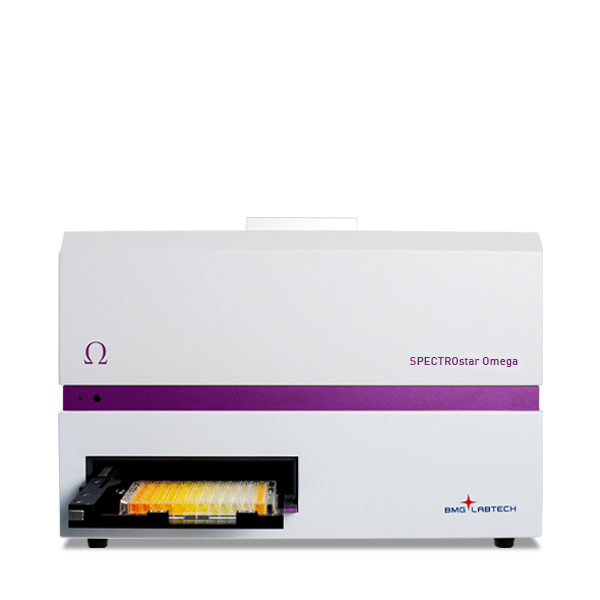
An ELISA plate reader is a piece of equipment capable of detecting and quantifying Enzyme-Linked Immunosorbent Assays. ELISAs are a popular tool to detect or quantify biological molecules in life science research. They are an essential technique in today’s laboratory with many applications and are often the method of choice to detect analytes for diagnostics, drug discovery or fundamental research.
Advantages of plate readers for ELISA detection
Incorporating sophisticated molecular devices, ELISA plate readers enhance assay capabilities, making them indispensable tools in modern laboratories for various research applications. Microplate readers offer several key advantages for the measurement of ELISAs. They are well suited to deliver a high-throughput detection as they are typically used with 96-well plates. Plate readers are compatible with automated liquid handling systems (microplate washer) and robotic platforms. These accelerate high-throughput screening and reduce errors that might be introduced by manual pipetting. The simultaneous automated detection of multiple samples or assays enhances throughput and efficiency, which allows for cost-effective solutions to be implemented.
Microplates offer solutions that allow researchers not only to scale up samples but also to scale down their assays according to experimental needs. They therefore provide flexibility in assay design and optimization whether researchers are screening large compound libraries or performing small-scale experiments.
What types of detection modes can be used for ELISAs?
ELISAs are immunoassays that utilise antibodies adsorbed on the bottom of the well of a microplate to bind and remove a specific antigen from the solution.
Today researchers have many detection options at their fingertips for ELISAs. However, absorbance remains the most frequently used detection mode. In absorbance-based assays, the antibody-antigen complex is then bound to an enzyme that catalyzes a colorimetric reaction: a colorless substrate is changed into a colored one. The intensity of the colour or signal is proportional to the amount of bound antigen and can hence be used for the quantification antigens in solution.
Colorimetric detection is frequently used in ELISAs due to its simplicity, cost-effectiveness, and compatibility with microplate readers. The two most encountered bioconjugated enzymes in colorimetric assays are horseradish peroxidase and alkaline phosphatase. Accordingly, ELISA plate readers are typically absorbance readers.
Fluorescence intensity, time-resolved fluorescence and luminescence assays are also used, though less common.
When talking about ELISA plate readers, absorbance microplate readers (also called spectrophotometer plate readers) are commonly referred to. These are used for different applications in different fields including immunology, molecular biology, virology, bacteriology, biotechnology, fungal biology, cancer and oncology (e.g. biomarker discovery), blood typing, autoimmune diseases, food science (including allergy testing), infectious disease surveillance, drug discovery and development as well as vaccine development, synthetic biology, and food or water quality monitoring. Absorbance-based ELISA plate readers can also be used for nucleic acid and protein quantification.
Compared to a standard cuvette-based spectrophotometer, an ELISA plate reader typically measures 96-well plates. High-end instruments can measure 384-well plates or even 1536-well plates.
- Initial recommendation
- Detailed Recommendation

Get help selecting the right microplate reader
Configure your microplate reader and get an initial recommendation!
What is an ELISA plate reader?
An absorbance ELISA reader requires an excitation light source, optics for the selection of the incoming wavelength, a detector, and a reference channel.
The sample on the plate is illuminated by light with a specific intensity. The total light intensity the probe is exposed to is assessed by a reference channel measured upfront. The detector is located on the opposite side of the microplate relative to the light source. It measures how much of the total light intensity is transmitted through the sample on the plate and at which wavelengths. Light that does not pass through to the detector is literally "absorbed" by the sample. Absorbance data are measured in optical density (OD).
The measured amount of transmitted light can be typically used to calculate the concentration of an analyte by means of a standard curve and wells of unknown concentrations.
ELISA plate readers are available as stand-alone readers or as part of multi-mode microplate readers, when combined with other detection modes and can include shaking and temperature control. Temperature control is not essential for ELISAs but necessary for the study of enzyme activity including enzyme kinetics. Another possible assay that could be measured is cell viability (MTT).
Do you want to use an ELISA plate reader in your lab?
Request a quote or ask for more information here:

If you are on the market for a new ELISA plate reader, there are a few factors to consider as the performance of the reader can significantly affect the quality of your research data.
ELISA plate readers typically employ a broadband light as an excitation source to cover as many assays and applications as possible. This is commonly either a tungsten halogen or a xenon lamp.
Light source
Halogen lamps are continuous light sources that cover a wavelength range from around 360 - 1000 nm. Hence, they are suited for ELISAs but do not allow for absorbance-based DNA/RNA (260 nm) and protein (280 nm) quantification. They have a short lifetime, a lower output intensity, and result in lower sensitivity when compared to xenon lamps in plate reader-based detection. Because of their cost-effectiveness, they are typically used on low-cost instruments.
Xenon flash lamps cover the spectral region from 220 - 1000 nm and are suited to be used for ELISAs and excite any molecule that absorbs light from the UV- to the infrared range. In addition, since they flash light, they combine a long lifetime with a high signal output when compared to halogen lamps.
BMG LABTECH equips all its microplate readers only with high-performance xenon flash lamps, providing more excitation energy over a broader spectral range and a larger range of assays at lower concentrations. This allows all types of biological, light-based assay data to be efficiently measured on a BMG LABTECH plate reader.
Wavelength selection
An optical design that includes the capability to filter or select absorbance wavelengths is mandatory and dependents on the type of detectors: Photomultiplier Tubes (PMTs) or Charge Coupled Device (CCD) spectrometers.
PMT-based microplate readers require a monochromator for absorbance spectral scanning. This selects the desired wavelength range and measures it sequentially upon mechanical movement.
Spectrometer-based microplate readers acquire the whole wavelength range of the light transmitted through the probe. This way, spectra, single, or multiple discrete wavelengths can be acquired in a shorter amount of time. Unlike in monochromators, no mechanical wavelength scanning is required. For spectral data acquisition, spectrometer-based plate readers are significantly faster than monochromator-based instruments.
Our single-mode and multi-mode readers are equipped with a UV-vis spectrometer for absorbance measurements. This captures a full-range spectrum from 220 to 1000 nm in less than a second/well.
Compatible microplate formats
Make sure your ELISA microplate reader of choice is capable of reading the microplate format you plan on using. ELISA assays are commonly measured in 96 well plates. If you require higher throughput and wish to use only few µL of sample to save precious reagents or time, 384 and 1536 well plates can also be used.
Software for data analysis
Generally, the software that runs the plate reader is a very underestimated part of the package. For some plate readers, the software only controls the measurement process and provides a raw data output. In other cases, it can also perform data analysis.
A comprehensive, easy-to-use and flexible software can make life easier, simplify detection and automatise data analysis.
The most useful calculation features include automatic blank subtraction and automatic calculation of concentrations based on standard curves.
On the BMG LABTECH software package, assays have a predefined quick-run protocol and dedicated analysis templates. Through these dedicated solutions, acquisition and analysis of a microplate are performed with a single mouse click.
![]()
Our ELISA/absorbance microplate readers
ELISA assays can be performed on the multi-mode microplate readers PHERAstar FSX, CLARIOstar Plus, VANTAstar, and FLUOstar Omega, as well as on the absorbance-only SPECTROstar Omega and SPECTROstar Nano plate readers. All readers are compatible with standard 96-well plates.
BMG LABTECH was the first company to employ a UV-vis spectrometer for absorbance measurements. Upon illumination of the probe on the plate by a high-power xenon flash lamp, our ultra-fast UV-visible spectrometer collects all wavelengths from 220 to 1000 nm in less than 1 second per well. This way your ELISA assays will no longer be limited by the type and number of filters you have at hand - all ELISA assays can easily be detected independently of their wavelength.


CLARIOstar Plus

VANTAstar

Omega Series

SPECTROstar Nano
Application notes with BMG LABTECH microplate readers
The following application notes are examples of ELISA absorbance detection taken on BMG LABTECH microplate readers:

Why to choose a BMG LABTECH absorbance plate reader?
BMG LABTECH is specialised in producing microplate readers only and brings more than 30 years of full expertise in plate reading technology. This knowledge gets visible in the reliable results that our instruments deliver - the only factor that counts in your lab! Our users can trust to obtain best results in sensitivity, speed and flexibility. Moreover, our single and multi-mode plate readers are developed to provide optimum performance for years. Our instruments are developed, produced and tested in Germany and are built to be extremely robust and reliable.
Buy only what you need
Due to their modularity, all our multimode plate readers can be equipped with different detection modes and cover a multitude of applications. Additional features can be upgraded. This gives you the chance to keep your options open even if you don’t use the full scope of your plate reader right at the bat.
All-round service and support
We strive to provide you with the very best customer service and support. If you need customer support, we are only a phone call or email away. During business hours, you immediately speak live to a person who is happy to assist. There is no automated phone system or waiting in a queue. Our scientists, engineers and technicians are always there to help.
Multi-user software package
All our instruments come with a multi-user software package that can be installed on as many computers as users requires, without the need to purchase licenses. Software updates for our microplate readers are of no charge within the first 12 month after purchase.











